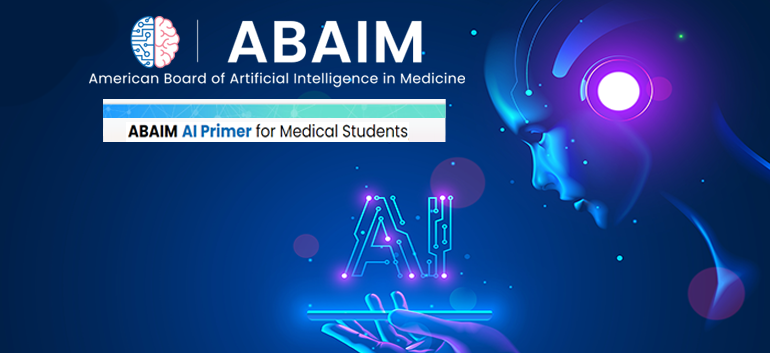Western University of Health Sciences partnered with the American Board of Artificial Intelligence in Medicine (ABAIM) to host an inaugural AI Primer for Medical Students conference. National experts, scientists, physicians, and medical students convened in a day long course designed for medical students to gain a working knowledge of basic Artificial Intelligence (AI) principles. Students learned the history of AI in medicine, became familiar with basic concepts in data science and machine learning, and explored the current and emerging applications of medical AI.
“The ABAIM would like to congratulate Western University of Health Sciences for being a vanguard school to include artificial intelligence in medical education for the future clinician. Di Lacey and the students and faculty deserve special recognition for promoting education not only for students to pass the boards, but far beyond this goal for their long-term career wellbeing,” said Anthony Chang, MD, MBA, MPH, MS, Chair of the ABAIM, Founder of Artificial Intelligence in Medicine (AIMed), and author of the textbook Intelligence-Based Medicine: Artificial Intelligence and Human Cognition in Clinical Medicine and Healthcare. Dr. Chang was the lead presenter at the event and is a pediatric cardiologist who is actively involved in furthering the use of AI in health care.
The event hosted several data experts and physicians who are leading much of the research and applications of AI at the bedside and beyond. Medical students had the opportunity to ask questions and drive the conversation in key areas of interest and concern. Many of the medical students in attendance have earned degrees in computer science, coding, engineering, biotechnology, and data sciences. A topic of discussion at the event was whether these types of degrees should be encouraged for students who apply to medical schools.
Orest Boyko, MD, PhD, Vice Chair of the ABAIM, and Professor Emeritus University of Southern California, championed this event for medical students and strongly supports student engagement in the evolution of this technology. “When I discussed this AI Primer for Medical Students concept with an East Coast dean of a school of medicine, he suggested that ‘AI education should ultimately be developed from the bottom up and not top down.’ Our students that attended the AI Primer are true innovation pioneers. This is a historic moment for AI as we are on the journey of inspiring our future physicians to ultimately develop and mature this new application of technology into the care and betterment of our patients,” said Boyko. Dr. Boyko is a radiologist who has used AI in his practice and presented case studies on AI ethics at the AI Primer event.
Western University of Health Sciences has had several medical students become certified in AI in medicine through the ABAIM and are now actively engaged in how these applications will change health care in the future. The ABAIM certification course was created for practicing physicians which places medical students shoulder-to-shoulder with clinicians who are actively incorporating AI into their practices.
Conor Davenport is a medical student at Western University of Health Sciences who has completed the certification course from the ABAIM. “Artificial intelligence in medicine drew my interest because of the importance I believe technology has played in medicine, and the greater importance I believe it will play in the future. ABAIM’s AI primer for medical students was not only a great introduction to AI but yielded new content even after having completed their more advanced courses. Thanks to their distillation of all the information on current initiatives using AI, ABAIM’s faculty has helped me focus on the salient bits of information needed to begin participating in using AI in practical settings. I look forward to enriching the relationship between ABAIM and WesternU in the future, and for the utility that AI promises for medical practice.”
The application of artificial intelligence in medicine has a broad scope of possibilities and is being used in a variety of ways. Since AI learns from data and detects patterns, it can help physicians diagnose diseases in the early stages. The data provided by wearable monitors, smartphones, and other digital monitoring sensors are expanding new opportunities for AI in medicine. Digitally tracking health issues such as seizures, blood sugar levels, blood pressure, and heart rhythms is currently common practice. In the future AI may help prevent or anticipate health issues before they occur.
“AI is on the road towards making huge changes in healthcare that can be beneficial to physicians around the world,” said WesternU medical student Craig Yamaguchi. “ABAIM’s primer for medical students was such a great way to get started in learning more about the benefits of AI and how feasible it is to adapt in clinical practice. The technology side of medicine has been advancing to great degrees every decade, and I plan on keeping up to date with the new innovations that are and will be made available with the help of ABAIM.” Yamaguchi is also one of the WesternU students who has achieved certification through the ABAIM.
AI is being used by physicians to improve accuracy, validate their diagnoses, and interpreting patient data faster. Currently, one of the most impactful areas for AI is in diagnostic imaging. Computer Aided Diagnosis (CAD) has been used for many years in mammography and lung imaging to help radiologists identify early cancers. Leveraging AI in other tests such as computerized tomography (CT), magnetic resonance imaging (MRI), and ultrasound is becoming widely accepted as best practice.
Di Lacey, Associate Vice President for WesternU’s Oregon campus, presented on the advances of AI in ultrasound at the event and is nationally registered in both ultrasound and radiology. “It is humanly impossible to synthesize the volume of information our systems can generate. Yet the key to exceptional medicine is leveraging that knowledge for data-driven decisions and emerging best practices,” stated Lacey. “The question isn’t should we use AI in medicine, but rather how and when. There’s a huge difference between intelligence and wisdom. This generation of physicians must know how AI works, but also gain the wisdom to know when it doesn’t.”
The ABAIM is a nonprofit organization whose mission is to educate all stakeholders in the domain of artificial intelligence in clinical medicine and healthcare. The mission of the ABAIM is maintaining and advancing knowledge and expertise in artificial intelligence and human cognition in clinical medicine and health care by certifying students and healthcare professionals who meet the standards of competency. Their vision is to improve understanding and application of artificial intelligence, to pursue improved outcome in clinical medicine and healthcare for all healthcare providers and services and to provide a solid-lasting foundation of ethics in AI.
Western University of Health Sciences (WesternU) has nine colleges, making it one of the most comprehensive health sciences universities in the nation. The College of Osteopathic Medicine of the Pacific (COMP) is currently the fourth largest medical school in the nation according to U.S. News & World Report. COMP is located on WesternU’s campus in Pomona, CA, while COMP-Northwest is located on the WesternU Oregon campus in Lebanon, OR. Combined, these two locations enroll 1320 medical students each year and provide a pipeline of future physicians.



